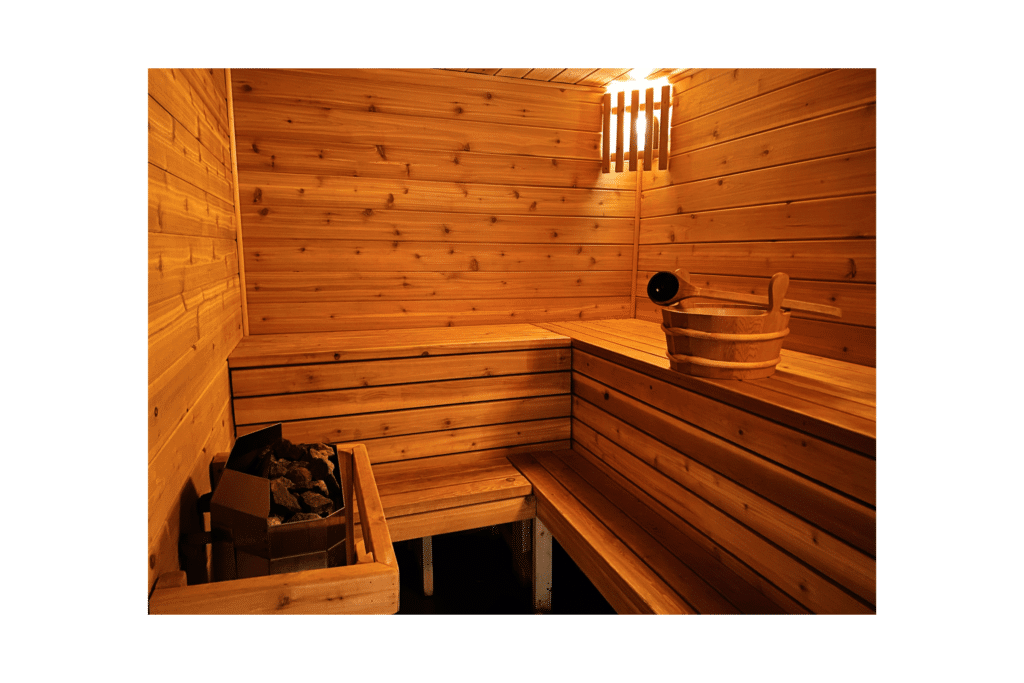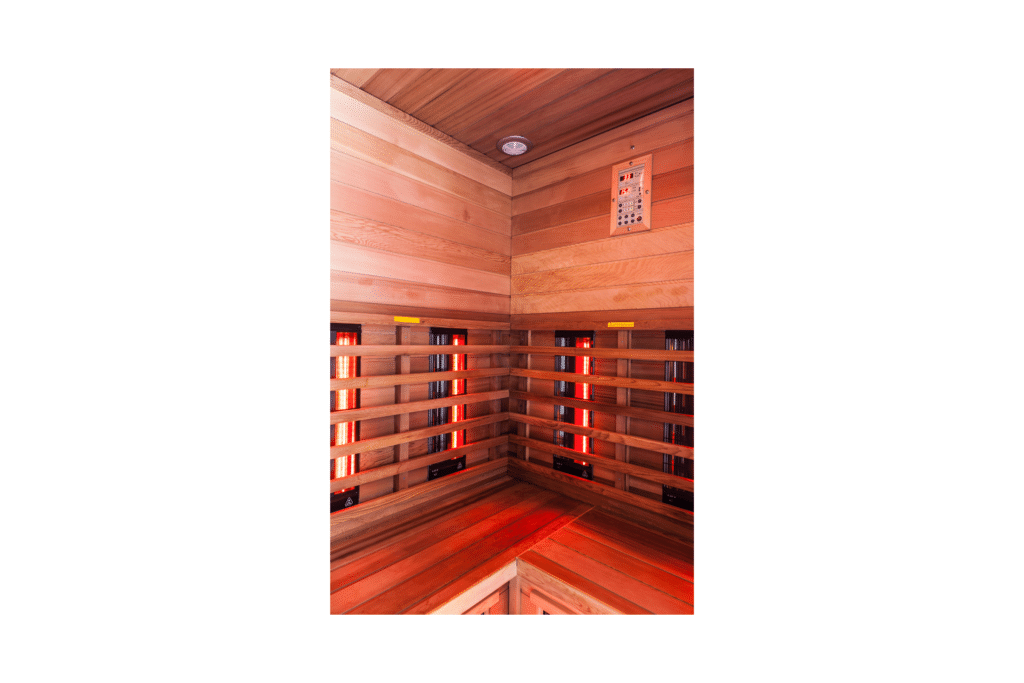There are numerous health benefits to spending time in the sauna. With its natural detoxifying benefits, sauna use has grown in popularity over the last few years, especially with people looking for more natural ways to detox themselves. That being said, one of the biggest questions when it comes to sauna use is how high the temperature gets inside the sauna vs. a steam room.
The average temperature of a traditional sauna ranges from 150-190°Fahrenheit or 66-88°Celsius, while infrared saunas will be 140-150°Fahrenheit or 60-66°Celsius. In comparison, steam rooms are cooler, with ideal temperatures of 110-120°Fahrenheit or 43-49°Celsius. Traditional saunas rely on wood, electricity, or gas for heat, while steam rooms use a generator filled with boiling water to create up to 100% humidity levels.
Read along for a deep dive into the average and ideal temperatures for optimal sauna or steam room use.
The average temperature of saunas and steam rooms

The temperature of saunas and steam rooms can vary and largely depend on the type of sauna you are using. Choosing the right sauna can take time, and you might need to try them all and figure out which type your body responds best to.
It is also important to realize that if it’s your first time using the sauna, getting acclimated to the temperatures might take some time. You should start slowly with the lowest temperatures you can tolerate and slowly increase the temperature as your body gets used to the sauna.
Here are the different types of saunas and the average and recommended temperatures that each one should have for optimal use:
| Type of sauna | Heating source | Average temperature | Ideal temperature | Humidity | Pre-heating time | Typical session length |
|---|---|---|---|---|---|---|
| Traditional dry sauna | Gas, electric, wood | 150-190°F | 150-175°F | 5-10% | 10-15 min. | 15-20 min. |
| Infrared sauna | Infrared lamps | 100-150°F | 120-130°F | None | 10-15 min. | 20-30 min. |
| Portable Infrared Saunas | Electric | 100-150°F | 120-130°F | None | 10-15 min. | 20-30 min. |
| Sauna Blankets | Infrared energy | 80-160°F | 120°F | 5% | 15 min. | 35-40 min. |
| Sauna Suits | Waterproof material like PVC | up to 90°F | 90°F | 5-10% | None | 5-10 min. |
| Steam Rooms | Generator filled with boiling water | 110-120°F | 110-115°F | Up to 100% | 10-15 min. | 20 min. |
When using saunas, remember that it is important to adhere to basic safety practices and ensure that you always keep yourself hydrated. Dehydration is the number one side effect of saunas and steam rooms, but as long as you stick to the recommended temperatures, you should be okay.
How hot is a traditional dry sauna?

A traditional dry sauna heats the air around you in an airtight room using an electric stove or traditionally burning the sauna rock using wood or a stove.
The traditional dry sauna temperatures range from 150-190°F. The higher end of this range is the typical temperature that you would see in a dry sauna.
Because of these temperatures, you will feel an elevation in your heart rate and an increase in blood circulation, leading to an increase in the metabolic process.
Saunas have been in existence for several thousands of years and have evolved and become more technologically advanced. Saunas were used in different cultures for different purposes back then, like purification rituals before marriage and burial rites.
Traditional saunas can use wood, electricity, and gas. The older and more traditional saunas use wood, while sauna rooms in gyms and hotels use electricity.
What is the ideal temperature for a dry sauna?
A dry sauna uses heat and the surrounding building materials to create the typical “sauna” experience, and there should be minimal humidity.
Traditional dry saunas can range from 150-190°F. The recommendation when it comes to ideal traditional sauna temperature ranges from 150-175°F. It is best to experiment within these ranges to reach an ideal temperature for your body.
This is the hottest type of sauna, as all the detoxifying benefits you get from the increased sweat, and elevated body temperature come entirely from the room’s ambient temperature.
Can a sauna be 200 degrees?

While most dry sauna temperature recommendations top out at 190°F, is it possible to go higher?
In the USA and Canada, the maximum temperature of saunas is 194°F (90°C). Saunas have temperature limit switches that can control the maximum temperature that a sauna can reach.
In other parts of the world, including Europe, saunas can reach up to 200-220°F. This is because the people who live in certain European countries have higher heat resistance and withstand the increased heat for longer.
How hot is too hot in the sauna?

Regardless of the recommended temperature in saunas, determining how high you can go is up to you. Some people can tolerate more heat than others, while others prefer to be on the lower side of the range.
The temperature of your sauna depends on your overall health and how much heat you can tolerate. If you have underlying health conditions – especially cardiovascular disease and blood pressure issues -you should talk to your doctor first before going in the sauna.
The recommendation for first-time users is to start slow and low. Once you have several sauna sessions under your belt, you can gradually increase the time inside and slightly increase the temperature.
If you feel faint or uncomfortable inside the sauna, stepping outside and stopping your sauna session is best. Ensure you are hydrated before and after each session to avoid any ill effects your body might have.
The National Health Service (NHS) cautions that overheating in a sauna or steam room could be detrimental to a pregnancy. Overheating is also more likely while pregnant.
What is the hottest sauna ever?
There used to be a world competition called Sauna World Championships that measured how long people can stay inside the sauna in extreme temperatures. This competition was put to a screeching halt in 2010 after a competitor passed away.
The hottest temperature that is ever recorded inside a sauna is 260°F.
Cranking up your sauna to high-temperature levels is not recommended, especially if you are just starting out. For safety reasons, US-manufactured saunas can reach a maximum temperature of 194°F.
How hot is an infrared sauna?

The main difference between an infrared sauna and a traditional sauna is that an infrared sauna needs electricity to run. It utilizes infrared heating panels to generate heat.
Because there is no need to heat all the space, the required temperatures in an infrared sauna can be lower and range from 100-150°F with the recommended temperature varying from 140-150°F.
Infrared saunas are newer technology and are a popular choice for home saunas because they require less electricity to heat up and use.
Why is an infrared sauna not as hot as a dry sauna?
The difference in temperatures between an infrared sauna and a traditional sauna is caused by the way the heat travels and transfers into your body.
Infrared saunas require lower temperatures than traditional saunas because they use infrared waves to heat your body from the inside.
On the other hand, traditional saunas require a higher temperature because it has to heat the space around you first, and the heat will travel from outside your body and slowly make its way in.
How hot is a steam room?

A lot of people refer to saunas and steam rooms interchangeably, and these two are very similar. Saunas use dry heat and can have much higher temperatures than steam rooms.
Steam rooms are generally cooler compared to saunas, with temperatures ranging from 110-120°F. Some people prefer steam rooms to saunas because the humidity from the steam can have additional benefits to your body like improving congestion, clearing your skin, helping with circulation, and improving blood circulation.
The use of steam rooms dates back to ancient times, with the Greeks and Romans regularly utilizing steam bathing as a way to socialize and obtain health benefits as well.
How hot can a steam room get?
While steam rooms feel incredibly hot, the temperature is actually lower than either a dry sauna or an infrared sauna.
Steam room temperatures generally vary from 110-120°F. The humidity inside a steam room can reach up to 100%.
This intense humidity means that your body is unable to cool itself by sweating, meaning that you feel hotter compared to a dry room at the same temperature.
Why is a steam room not as hot as a traditional dry sauna?
The difference in temperatures between a steam room and a traditional dry sauna is caused by the different types of heat that each one uses.
A traditional dry sauna uses dry heat from a heater or putting water in hot coals. On the other hand, steam rooms use heavily moisturized air that emanates from boiling water.
Steam rooms rely on humidity as opposed to actual heat, so steam rooms are generally cooler than saunas. Saunas and steam rooms often have choices of seat levels to choose from. Higher seating will prove to be hotter since the heat rises.
You can use a dry sauna and a steam room on the same day. Just be sure to stay hydrated.
How hot do portable saunas get?

Portable saunas are more compact and cost-efficient than traditional saunas and steam rooms.
For people who have limited space in their home and can’t put it in a sauna or steam room, portable saunas are space savers and easy to use. These are usually zip-up encasements that can fit one person. It is designed to trap heat and steam to mimic the effect of a real sauna.
These types of saunas can reach up to 150°F which is quite impressive, and can even reach up to 100% humidity levels.
Sauna suits are cheaper alternatives to the sauna, are also portable, and can be plugged in anywhere, making it easy to take on the go.
How hot do sauna blankets get?
Another alternative to a traditional sauna is sauna blankets.
With temperatures ranging from 80-160°F, you can wrap a sauna blanket all over your body. Infrared sauna blankets are a popular option because they give you the effects of a sauna without too much heat.
Sauna blankets are designed for those who want the benefits of a sauna but are on the go and can’t necessarily go into a traditional sauna or steam room. This alternative can also give you all the benefits of a regular sauna.
How hot does a sauna suit get?
Sauna suits are waterproof tracksuits that work to retain your body’s perspiration and heat levels while you work out.
Sauna suits can reach up to 90°F with 30-50% humidity. These suits are generally used for weight loss
and can help shed water weight.
Sauna suits can encourage sweat losses that are more significant than regularly working out.


